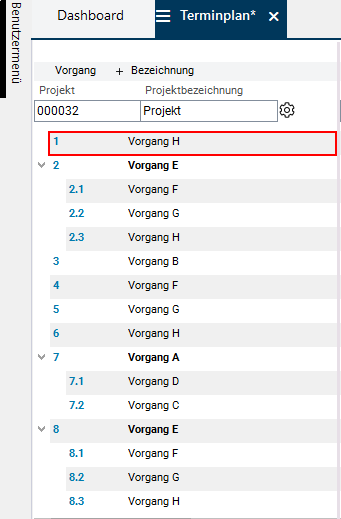Copy and Move via Drag & Drop
Information
- Below, you will learn how to
- copy field contents, column contents, and records
- move records
- edit records by using arithmetical operations while copying via Drag & Drop, using PLANTA’s own Drag&Drop mimic.
PLANTA Drag&Drop
- Copy: CTRL + left-click and drag to the required position while holding down the left mouse button and subsequently release the mouse button
- Move: SHIFT + left-click and drag to the required position while holding down the left mouse button and subsequently release the mouse button
- As an alternative, you can also use the arrow buttons as well as the page up/page down and Pos1/End keys.
- If the position to which records are to be copied or moved is not visible, the bar scrolls to that area automatically when dragging with the mouse.
Drag & Drop Copying of Data
Video Tutorial
Information
- Output and input fields may be used as a source for Drag&Drop operations.
- You cannot copy to output fields.
- The database type of source and target object determines whether you can copy from one object (field/column) to another.
- You can, e.g., copy from a currency field to a text field, but not vice versa.
- If copying is not permitted, the Unable to copy message will be displayed after you have released the left mouse button.
Field to Field
Objective
- To copy an entry from one field to another.
Procedure
- Drag the content of the source field to the target data field by pressing CTRL + holding down the left mouse button.
- As a result, the source field is colored green and the destination field is colored blue.
- The cursor display is changed and the copying type is graphically displayed.
- As soon as the cursor is on the target field, release the left mouse button.
- The value of the source field is copied to the target data field.
Note
- The Field to Field copy type is set by default.
- If you have changed the copy type while copying, you can change to the Field to Field type again using the Edit → Drag&Drop copy → Field to field menu item or via shortcut CTRL + 1.
- You cannot only copy field content between records within a module but also between two modules.
- You can copy, e.g., the resource ID from the Resource Structure module to the Resource Data Sheet module.
Field to Column
Definition
- It is distinguished between data logical and layout related columns.
- A data logical column contains the same data field in all records of a data area.
- In the horizontal layout, a visual column is equivalent to a data logical column.
- Compare: columns in Microsoft Excel.
- In the vertical layout, a line is equivalent to a data logic column (the record is a column here).
- In forms there are no visual lines or columns. Here, one data field corresponds to one data-logical column in all form records.
- In the horizontal layout, a visual column is equivalent to a data logical column.
- The following examples are explained on the basis of a module with a horizontal layout.
Objective
- To fill the marked fields in a column with a particular value.
Procedure
- Mark target records.
- Define the copy type via the Edit → Drag&Drop copy → Field to column menu item or by using the CTRL + 2 shortcut.
- Drag the content of the source field to the destination column by pressing CTRL and holding the left mouse button.
- The cursor display will change and the copying type will be displayed graphically.
- Release the left mouse button as soon as the cursor is on the target field.
- The source data field value is copied to all data fields of the destination column for all marked records.
Notes
- As target column you can use the column from which the source data field stems or another column.
- Drag&Drop copy → Field to column behaves on projection data fields like Drag&Drop copy → Field to field.
Column to Column
Objective
- To copy the contents of the fields from one column to another
Procedure
- Mark target records.
- Define the copy type via the Edit → Drag&Drop copy → Column to column menu item or by using the CTRL + 3 shortcut.
- Drag the content of the source column to the target column by pressing CTRL and holding down the left mouse button.
- The cursor display will change and the copying type will be displayed graphically.
- Release the left mouse button as soon as the cursor is on the target field.
- The source column field value is copied to all data fields of the destination column for all marked records.
Note
- Drag&Drop copy → Column to column behaves on projection data fields (fields below the time scale) like Drag&Drop copy → Field to field.
Copy Operation
Information
- You can use Drag&Drop with arithmetical operations for all copy types Field to field, Field to column and Column to column.
- The following example describes the Field to column copy type with Addition operation.
- The procedure for other copy types and other copy operators is identical.
Objective
- To copy a value from a source data field to a destination column and change the value at the same time.
Procedure
- Mark target records.
- Define the copy type via the Edit → Drag&Drop copy → Field to column menu item or by using the CTRL + 2 shortcut.
- Select an operator via Edit → Copy operation ( e.g. + (Addition)).
- Drag the content of the source field to the destination column by pressing CTRL and holding the left mouse button.
- The cursor display will change and the copying type will be displayed graphically.
- Release the left mouse button as soon as the cursor is on the target field.
- The dialog box: Add: will be displayed. Enter the required figure and confirm the message by clicking on OK.
- The value calculated on the basis of the selected operator and figure is entered in all field of the target column for all marked records.
Drag & Drop Copying/Moving of Data
Video Tutorial
Information
- The positioning logic is the same for both methods. The only difference is that
- when copying, a new record will be created and
- when moving, the very record will be moved to the other position.
- The terms source and target are central in copying/moving.
- The Source is the record
- which you want to copy or move.
- It is visualized in green during copying or moving.
- The target is the target position (the position to which the source record is to be moved), a position below, above, or on a record.
- The position below/above the record to which you want to move/copy is visualized by a dark blue line and three black arrows pointing down/up.
- The position on the target record will be colored in light blue (the entire record will be colored in light blue).
- The Source is the record
Details
- You can use the Copy/Move function to structure records.
- An illustration of the copying/moving procedure, can be found in the following sections:
Notes
- Drag&Drop copying/moving of records between modules is not permitted.
- Structuring records is not allowed for all modules.
- If structuring is not allowed, records you want to structure will simply be moved or copied.
Procedure
- All following examples are based on the Schedulemodule.
- To be able to follow the instructions below, insert 8 new tasks in the schedule of an empty project and name them from "Task A" to "Task H”.
- Save and click on the
 Generate WBS code button below the project bar in order to automatically generate the IDs for the tasks.
Generate WBS code button below the project bar in order to automatically generate the IDs for the tasks. - Result:
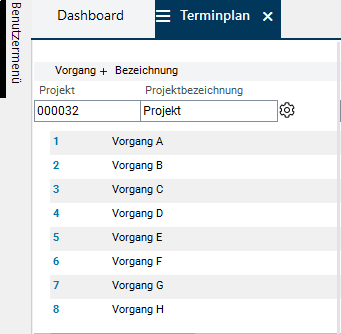
Move
Notes
- In the customizing settings, the movement of records can be permitted or prohibited.
- If moving is not allowed, the following message will be displayed after releasing the left mouse button: Cannot perform move.
- It is not possible to move a parent record to its child record.
- The source record is always copied/moved including all of its child records.
Moving and Structuring
Subordinate
Tasks 2 and 3 are to be subordinated to task 1.
- Mark tasks 2 and 3 and drag them to task 1 by pressing SHIFT + holding down the left mouse button.
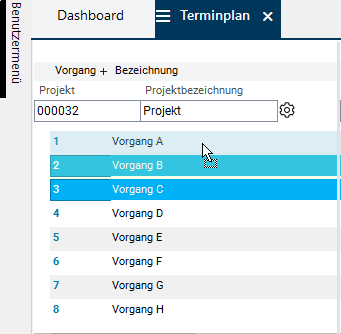
- Release the left mouse button.
- Result: Tasks 2 and 3 have been moved under task 1.
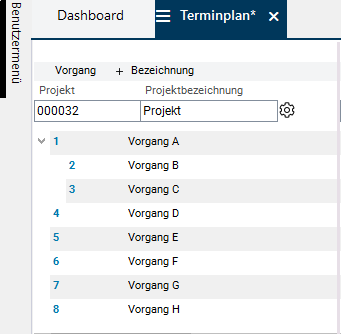
Task 4 should also be a child of task 1 and should be positioned under task 3.
- Drag task 4 below task 3 by pressing SHIFT and holding down the left mouse button, so that a dark blue line is displayed below task 3.
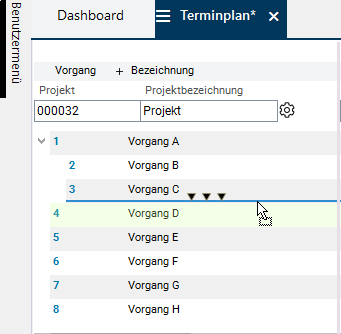
- Release the left mouse button.
- Result:
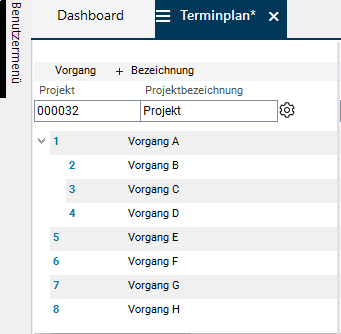
- Save and click on the
 Calculate schedule button in the toolbar.
Calculate schedule button in the toolbar. - Result: Task 1 is displayed in bold and is therefore visualized as a summary task.

- Click on the
 Generate WBS code button next to the project name.
Generate WBS code button next to the project name. - Result: The new structure is mapped.
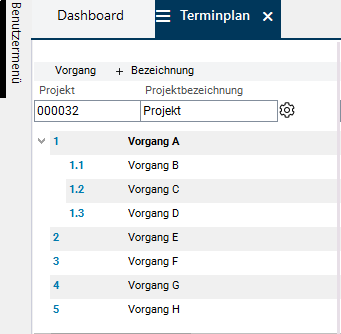
Outdent
Task 1.1 is to be outdented (it is no longer to be a child of task 1).
- You can outdent the task by moving the child record above or below the required parent record. This can be both your own parent task as well as any other parent task, depending on where the operation to be disengaged is to be positioned.
- The task is placed at the position to which it is moved with the mouse.
- By pressing SHIFT and holding the left mouse button, drag task 1.1 above task 3 so that a dark blue line appears above task 3.
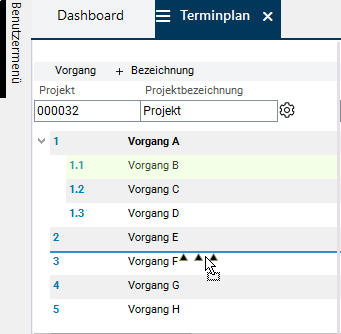
- Release the left mouse button.
- Result: Task 1.1 has been positioned at the highest level above task 3 and is therefore no longer a parent task.
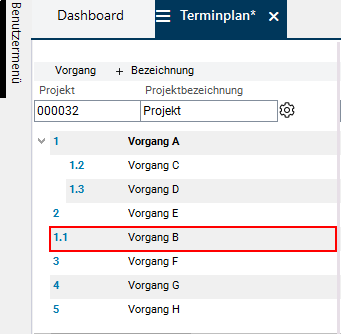
- Click on the
 Generate WBS code button next to the project name.
Generate WBS code button next to the project name. - Result: The new structure is mapped.

Moving without Structuring
Task 1.2 is to be positioned above task 1.1.
- By pressing SHIFT and holding the left mouse button, drag task 1.2 above task 1.1 so that a dark blue line appears above task 1.1.
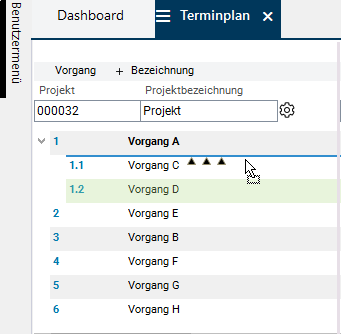
- Release the left mouse button.
- Result:
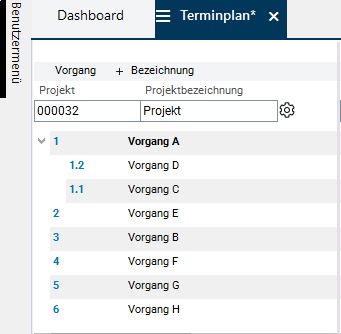
Summary task 1 and its children are to be positioned below task 6
- By pressing SHIFT and holding the left mouse button, drag task 1 below task 6 so that a dark blue line appears below task 6.
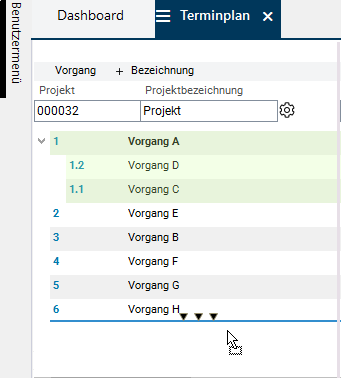
- Release the left mouse button.
- Result:
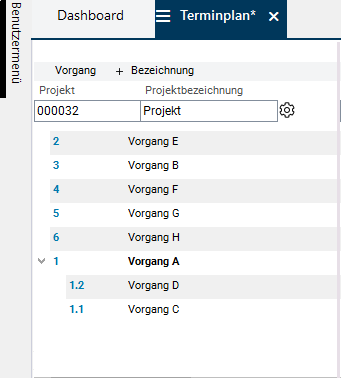
- Save and click on the
 Generate WBS code button below the project bar.
Generate WBS code button below the project bar. - Result: The new structure is mapped.
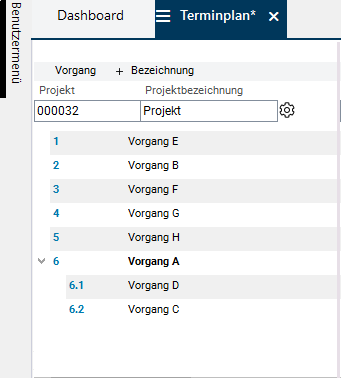
Copy
Notes
- When records are copied, the IDs of the target objects will be newly created.
- Other IDs in the target object may be adjusted too.
- Values of the output fields are not included when copying.
- Values of the source object input fields, also those of hidden input fields, will not be included when copying.
- Only visible records will be copied. I.e. if you copy a record that has some of its child records hidden in the module via filter criteria, only the visible child records will be included.
Structure by copying
Information
- In order to copy entire records, the following setting must be made:
- Select Edit → Drag&Drop copy → Record/s in the menu bar or use the CTRL + 4 shortcut.
Copies of tasks 3 and 4 are to be created and to be subordinated to task 1 at the same time
- Mark tasks 3 and 4 and drag them to task 1 by pressing STRG + holding down the left mouse button.
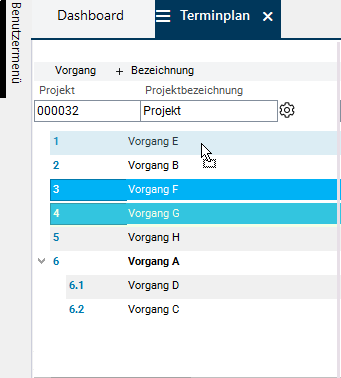
- Release the left mouse button.
- Save and click on the
 Generate WBS code button.
Generate WBS code button. - Result: Tasks 1.1 and 1.2 have been created automatically using the data from tasks 3 and 4 and assigned to task 1.

Furthermore a copy of task 5 is to be created and to be subordinated to task 1 as well.
- Drag task 5 below task 1.2 by pressing CTRL and holding down the left mouse button.
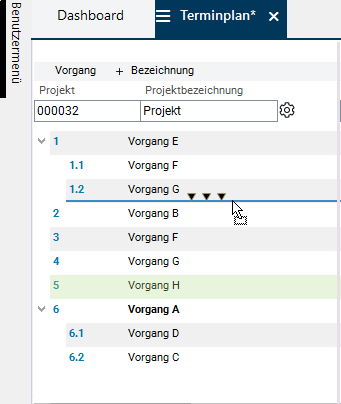
- Release the left mouse button.
- Save and click on the
 Generate WBS code button.
Generate WBS code button. - Result: Task 1.3 has been created automatically using the data from tasks 5 and assigned to task 1.2.
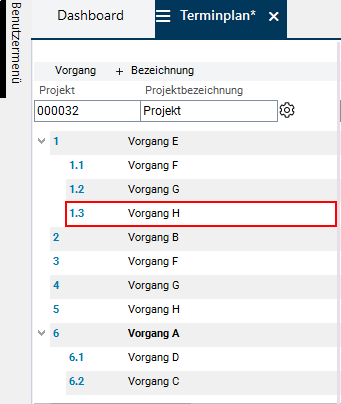
- Save and click on the
 Calculate schedule button in the toolbar.
Calculate schedule button in the toolbar. - Result: The parent task is now visualized in bold font.
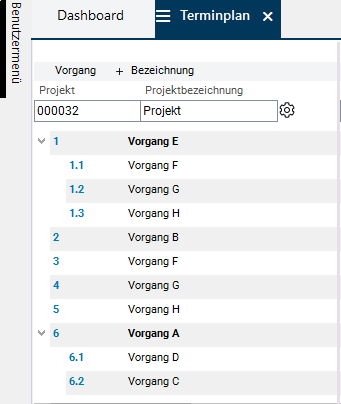
Copying without Structuring
Information
- In order to copy entire records, the following setting must be made:
- Select Edit → Drag&Drop copy → Record/s in the menu bar or use the CTRL + 4 shortcut.
A copy of summary task 1 should be created and positioned below task 6 too.
- By pressing CTRL and holding the left mouse button, drag task 1 below task 6 so that a dark blue line appears below task 6.

- Release the left mouse button. If CTRL is released too soon, the record will not be not copied.
- Save and click on the
 Generate WBS code button.
Generate WBS code button. - Result: Summary task 7 has been created automatically using the data from task 1 and positioned below task 6.
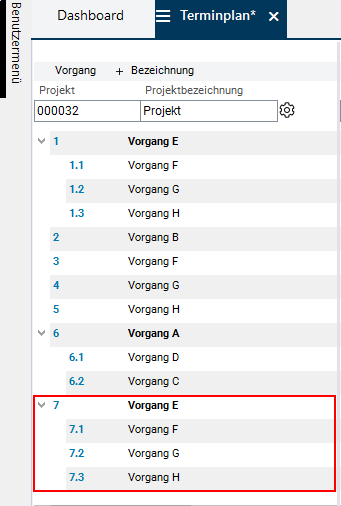
A copy of task 5 should be created and positioned below task 1 as well.
- Drag task 5 above task 1 while pressing CTRL and holding down the left mouse button, so that a dark blue line appears above task 1.
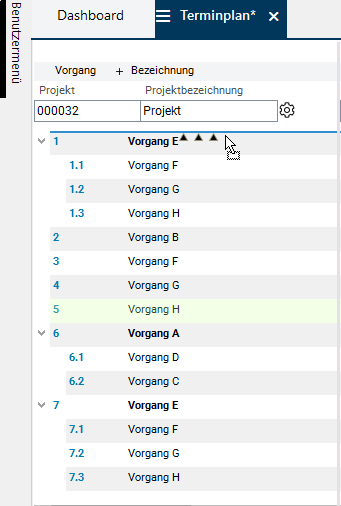
- Release the left mouse button.
- Result: A new task has been created automatically using the data from task 5 and positioned above task 1.
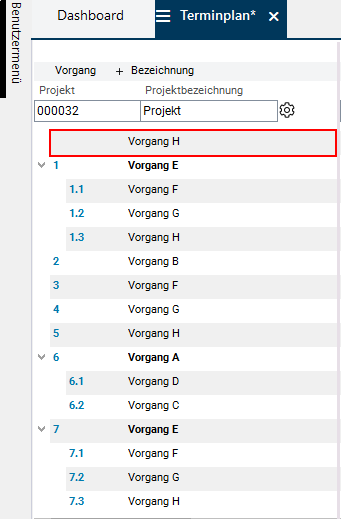
- Save and click on the
 Generate WBS code button.
Generate WBS code button. - Result: Due to the positioning at the highest level, the new task becomes task 1.
